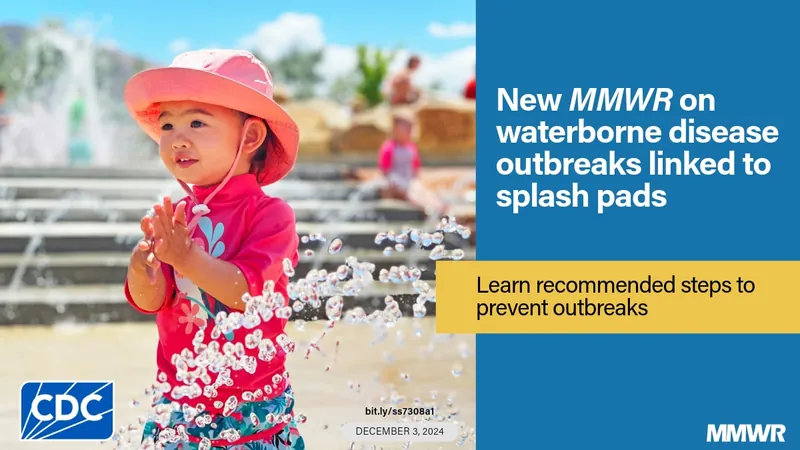
The Hidden Dangers of Splash Pads: Waterborne Disease Outbreaks Exposed (1997-2022)
2024-12-05
Author: Ling
The Splash Pad Phenomenon
Splash pads—often referred to as water playgrounds, interactive fountains, or spray parks—have become popular recreational spots for families since their introduction in the 1990s. Unlike traditional swimming pools, these facilities are designed to prevent standing water, minimizing drowning risks. However, this safety feature does not preclude splash pads from being linked to serious waterborne disease outbreaks.
Recent data spanning from 1997 to 2022 reveals alarming trends associated with splash pads. Public health officials reported a staggering 60 outbreaks tied to these venues, impacting 10,611 individuals, 152 of whom required hospitalization. While no deaths were recorded, the potential risks associated with splash pad use cannot be underestimated.
Behind the Outbreaks: What’s Going Wrong?
Most splash pad-related outbreaks have been attributed to Cryptosporidium, a resilient parasite resistant to chlorine disinfection. This microorganism is often passed through contaminated feces, and children—especially those in diapers—are particularly vulnerable. The health implications are severe, with acute gastrointestinal illnesses frequently reported among young children who often ingest water from these facilities.
The CDC’s investigation highlighted that from 1997 to 2022, Cryptosporidium was responsible for 40 outbreaks, accounting for 91% of reported cases. Other pathogens implicated include Shigella, Escherichia coli O157:H7, Giardia, norovirus, and various bacteria linked to water contamination, underscoring the serious health risks present in seemingly innocuous water fun zones.
Temporal Patterns and Regulatory Gaps
Seasonality plays a critical role, as a staggering 95% of reported outbreaks occurred during the warmer months of May to August. While splash pads are intended to provide carefree enjoyment, their operation often escapes strict public health regulations. Before 2000, only 13 states enforced oversight for these facilities. However, as more outbreaks have surfaced, several jurisdictions, including Oregon, have started to implement health regulations, but much work remains to standardize safety measures across the nation.
What Needs to Change?
Improvements in safety protocols for splash pads are urgently needed. Current recommendations by the CDC's Model Aquatic Health Code emphasize the importance of maintaining a chlorine level of at least 1 ppm, but achieving this in a dynamic splash pad setting poses significant challenges. Factors such as environmental exposure, inadequate maintenance, and system failures lead to decreased chlorine efficacy.
Furthermore, the establishment of secondary disinfection systems—like ultraviolet (UV) light or ozone treatment—could drastically reduce the risk of Cryptosporidium contamination. Such measures, already recognized in the latest CDC guidelines, address the necessity for enhanced pathogen control specific to splash pads, thus safeguarding public health.
Conclusion: Prioritizing Family Safety
As splash pads continue to thrive as favored summer destinations, recreational facilities must prioritize public health. Parents and caregivers should be educated on safe splash pad use, including the importance of maintaining hygiene and supervision, especially for young children. Simultaneously, municipalities should enforce stricter regulations and conduct regular inspections to ensure all splash pads operate safely.
With the summer season upon us, awareness and action can help prevent the next wave of splash pad-related outbreaks, keeping water fun safe for everyone!



 Brasil (PT)
Brasil (PT)
 Canada (EN)
Canada (EN)
 Chile (ES)
Chile (ES)
 España (ES)
España (ES)
 France (FR)
France (FR)
 Hong Kong (EN)
Hong Kong (EN)
 Italia (IT)
Italia (IT)
 日本 (JA)
日本 (JA)
 Magyarország (HU)
Magyarország (HU)
 Norge (NO)
Norge (NO)
 Polska (PL)
Polska (PL)
 Schweiz (DE)
Schweiz (DE)
 Singapore (EN)
Singapore (EN)
 Sverige (SV)
Sverige (SV)
 Suomi (FI)
Suomi (FI)
 Türkiye (TR)
Türkiye (TR)